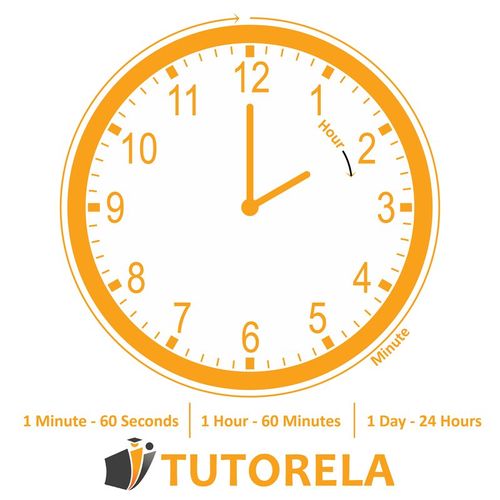minute = seconds
hour = minutes
1 day (whole, including night) = hours.
Measuring Time
Measuring Time
The figures that appear after the colon symbolize the minutes.

Measuring Time
In this article, you will learn to measure time!
You will be able to know, without asking anyone, when a minute has passed or when two have passed, plus, you will be able to easily solve word problems that include times. Shall we start?
If you already know how the clock that counts time works, it will be easier for you to understand this chapter, but if you don't know, you shouldn't worry!
The clock counts the seconds... tick tock...
In a whole minute - there are seconds.
Therefore, in half a minute - there are seconds.
In an hour - there are minutes.
And in a day - there are hours.
Does this confuse you? Let's make sense of it
minute = seconds
hour = minutes
1 day (whole, including night) = hours.
If you look closely at a clock, you will see that the second hand counts exactly seconds over the course of a minute.
For a whole hour to pass, the minute hand must make a complete turn of minutes.
How are the hours of the day written?
If it's about the morning hours and the hours after midnight, they are seen just as they are.
For example:
in the morning
in the morning
and so on... until
From noon we write the hours differently:
One in the afternoon will be
Two in the afternoon will be
Three in the afternoon will be
Four in the afternoon will be
Five in the afternoon will be
Six in the afternoon will be
Seven in the evening will be
Eight in the evening will be
Nine in the evening will be
Ten in the evening will be
Eleven at night will be
Twelve at night will be
From here we return to the normal representation:
One after midnight will be
Two after midnight will be
Three after midnight will be
Four after midnight will be
Five in the early morning will be and so on...
Remember! This change occurs from noon until midnight.
We always write the nighttime and morning hours with their small numbers, just as you know them.
From noon until midnight, we will write them with this small modification.
Note - The figures that appear after the colon symbolize the minutes.
For example: means and minutes in the morning.
When we have after the colon, it means it is half an hour.
When we have after the colon, it means it is a quarter of an hour.
Let's practice now!
Exercise 1
Daniela visited Romi at her house from until .
How long was Daniela at Romi's house?
Solution:
Let's subtract
Daniela was at Romi's house for three hours.
Exercise 2
The class schedule starts at and ends at
How long does the school day last?
Solution:
First, we will calculate the number of hours in a school day and leave the minutes aside.
Remember that we still have another minutes after the hour , therefore, we will conclude that the school day lasts hours and minutes.
Exercise 3
Another question:
Veronica was in a private class from until .
How long did the class last?
Solution:
In exercises of this kind, it is advisable to take a moment and understand the question well.
Here's a tip: round the start time of the class like this -
Remember that you have set aside minutes. Since .
Now calculate how much time there is from until
One hour and minutes.
Now we will add the minutes we had set aside - minutes to the hour and ten and we will arrive at:
One hour and minutes.
Another way to solve it is by trying to convert the hours into the same amount of minutes. That is:
Calculate how long the class would last if it started at and ended at .
And, of course, we must remember that we added imaginary minutes.
This will give us that the answer is two hours minus minutes, which is, in fact, one hour and minutes.
Exercise 4
Another question:
How many seconds are there in minutes and a half?
Solution:
We have learned that, in one minute there are seconds.
Therefore, in minutes there are:
seconds.
In half a minute there are seconds since .
So, in three and a half minutes there are seconds.








